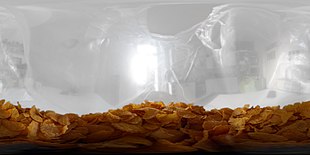cornflakes
Cornflakes ([ ˈkɔrnfleːks ], English corn " corn " and flakes "flakes") are breakfast cereals made from cooked, rolled and then dried corn, usually sugar and other ingredients. They are usually consumed with milk or fruit juices or are sometimes part of muesli . Cornflakes are mostly made up of carbohydrates .
history
At the end of the 19th century, the doctor John Harvey Kellogg and his brother Will Keith Kellogg developed corn flakes. They had been looking for a healthy vegetarian staple food for their patients to aid their recovery processes. Their recipe consisted of boiled, then pressed and heat-dried wheat , prepared in this way in thin, crispy flakes and eaten with a little salt. This rather accidental discovery was marketed by Will Keith Kellogg in his newly formed company, Battle Creek Toasted Corn Flake Company , starting in 1906 . In 1922 the company was renamed the Kellogg Company .
John Kellogg's method was later applied to corn and a similar method was applied to rice. From this, for example, the grain bars and many other products of the food industry emerged .
When Kellogg introduced the cornflakes, they said they would reduce indigestion and the need for masturbation . He chose this marketing route in close consultation with the Seventh-day Adventists to which he belonged.
Economical meaning
Shortly after the start of the industrial production, the Kellogg Company got into a supply shortage and launched a legendary series of advertisements: ". For thirty days please stop eating toasted corn flakes" ( ". Please eat 30 days no toasted corn flakes" ) was the effect not wanted, but clearly - demand exploded. After the great success in the United States, the cornflakes were introduced in Canada around 1915, later in Australia, England and from there to continental Europe. In Germany, cornflakes were first produced by H. & J. Brüggen in 1965 . Cornflakes can now be found in almost every supermarket around the world. They are available in many variants, in mixes, as salty or sweet dishes and with different additions.
Average composition
The composition of cornflakes naturally fluctuates, both depending on the respective recipe and the environmental conditions (soil, climate) and also on the cultivation technique (fertilization, plant protection).
Details per 100 g of edible portion:
|
|
|
* Protein content according to the EU directive on nutrition labeling; (Factor: 6.25): 7.7 g
** Difference calculation
1 mg = 1000 µg
The physiological calorific value of the digestible components is 1498 kJ / 100 g (353 kcal / 100 g).
Individual evidence
- ^ The Secret Ingredient in Kellogg's Corn Flakes Is Seventh-Day Adventism , smithsonianmag.org, accessed August 17, 2019
- ↑ German Research Institute for Food Chemistry (DFA), Garching (Hrsg.): Food table for practice . The little souci · specialist · herb. 4th edition. Wissenschaftliche Verlagsgesellschaft mbH, Stuttgart 2009, ISBN 978-3-8047-2541-6 , p. 230 .
literature
- Harry D. Schurdel: The world breakfast . In: Franz Metzger (ed.): Zipp and zu . Stuttgart 2008. ISBN 978-3-8062-2165-7 , pp. 14-16.
- Waldemar Ternes , Alfred Täufel, Lieselotte Tunger, Martin Zobel (eds.): Food lexicon . 4th, comprehensively revised edition. Behr, Hamburg 2005, ISBN 3-89947-165-2 . , see corn flakes, p. 1123


